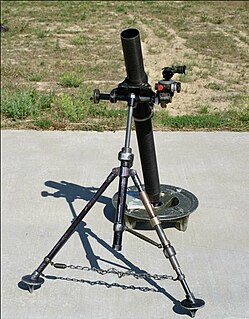 W
WThe 8 cm Granatwerfer 34 was the standard German infantry mortar throughout World War II. It was noted for its accuracy and rapid rate of fire.
 W
W81 KRH 71 Y is a light mortar manufactured by Tampella for use by the Finnish Army. It is usually used to support the infantry by indirect fire, but it can also be used for direct fire. Each Finnish infantry company has a platoon of 81 mm mortars. The mortar platoon consists of three seven-man mortar squads, each squad manning a single 81 mm mortar. Jaeger Company M2005 has a fire support squad, which consists of two five-man mortar teams, both equipped with an 81 mm mortar. It can fire HE-fragmentation, smoke, illumination and practice rounds.
 W
WThe United Kingdom's L16 81mm mortar is the standard mortar used by the British armed forces. It originated as a joint design by the UK and Canada. The version produced and used by Australia is named the F2 81mm Mortar, whilst the version used by the U.S. armed forces is known as the M252.
 W
WThe Mortier de 81mm léger long renforcé is a mortar used by the French Army, manufactured by Thales. Introduced in 1997, it is the latest iteration of the TDA 81 mm light mortar family.
 W
WThe M1 mortar is an American 81 millimeter caliber mortar. It was based on the French Brandt mortar. The M1 mortar was used from World War II until the 1950s when it was replaced by the lighter and longer ranged M29 mortar.
 W
WThe M29 is an American-produced 81 millimeter mortar. It began replacing the M1 mortar in U.S. service in 1952 being lighter and with greater range. It was subsequently replaced by the M252 mortar in 1987. Variants included the M29E1 and M29A1, adopted in 1964. These were produced with a hard chrome-plated bore to prolong barrel life and ease of cleaning.
 W
WThe Ordnance ML 3-inch mortar was the United Kingdom's standard mortar used by the British Army from the early 1930s to the late 1960s, superseding the Stokes mortar. Initially handicapped by its short range compared to similar Second World War mortars, improvements of the propellant charges enabled it to be used with great satisfaction by various armies of the British Empire and of the Commonwealth.
 W
WThe Type 97 81 mm infantry mortar was a Japanese mortar used primary by Imperial Japanese Army during World War II. The Type 97 designation was given to this gun as it was accepted in the year 2597 of the Japanese calendar (1937). It entered service in 1937. Japanese infantry units often are equipped with 81-mm mortars. The Type 97 81 mm mortar is very commonly used and is referred to by the Japanese as an "Infantry Gun", which breaks down into 3 sections for transport. The markings which appear on the base of the barrel read "97 model small trench mortar."